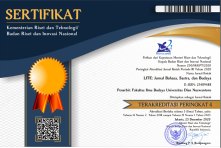Directive Illocutionary Act Produce by the Characters in Cruella Movie
Abstract
Abstract
This study aims to determine the types of the directive act and its function found in the American Disney movie Cruella, released in 2021. The study was conducted with the observation method and analyzed using quantitative and qualitative methods. The researcher collected the data through several steps, such as watching the movie several times, taking note of the utterance indicated as a directive act, and classifying the utterance into the types of the directive. The theory proposed by Searle (1979) was applied to analyze the data. Therefore, this study found that 51 utterances were considered directive acts. The data is divided into five types, including ask (16), suggest (10), forbid (7), order (9), and request (3). From the total data, asking became the most frequent frequency in the movie since the character frequently used the question to get the hearer to give an answer or the information. The occurrence of suggestions on the second rank of total data found follows it. The speaker produces the type of suggestion to suggest the hearer do an action.
Abstrak
Tindak Ilokusi Directif yang Diucapkan oleh Tokoh pada Film Cruella
Tujuan dari penelitian ini adalah untuk menemukan tipe tindak ilokusi direktif dan fungsinya pada film produksi Disney, Amerika yang berjudul Cruella yang tayang di tahun 2021. Penelitian ini dilakukan dengan metode observasi dan dianalisis menggunakan metode kuantitatif dan kualitatif. Peneliti mengumpulkan data melalui berbagai tahapan, seperti menonton film Cruella beberapa kali, mencatat ucapan yang terindikasi sebagai tindak ilokusi direktif, dan mengklasifikasikan ucapan tersebut kedalam tipe-tipe tindak ilokusi direktif. Teori yang dicetuskan oleh Searle (1979) diaplikasikan untuk menganalisis data. Dengan demikian, hasil penelitian menunjukan terdapat 51 ujaran yang dianggap sebagai tindak tutur direktif. Data dibagi menjadi lima tipe yaitu pertanyaan (16), saran (10), larangan (7), perintah (9), permintaan (3). Dari total data, tipe pertanyaan menjadi tipe yang paling sering muncul di film karena tokoh pada film sering menggunakan pertanyaan untuk membuat pendengar memberikan jawaban atau informasi. Jumlah tipe pertanyaan diikuti oleh penggunaan dari tipe saran yang berada pada posisi kedua sebagai tipe yang paling sering muncul dari total data. Pembicara menyampaikan sesuatu dengan saran untuk menyarankan pendengar dalam melakukan sesuatu.
Keywords
Full Text:
PDFReferences
Austin, J. L. (1962). How to do to Things with Words. The Clarendon Press.
Creswell, J. W., & Creswell, J. D. (2018). Research Design Qualitative, Quantitative, and Mixed
Methods Approaches (Fifth edit). SAGE Publications, Inc.
Darmayasa, D. (2016). Directive Illocutionary Acts Found in the Main Charater in Despicable Me 2 Movie [Skripsi]. STIBA Saraswati.
Dewi, C., Juniartha, & Karya, S. (2021). The Analysis of Directive Function in the Fifty Shades Freed Novel. Traverse.
Hymes, D. (1972). The ethnography of speaking. In J. A. Fishman (Ed.), Reading in the Sociology of Language. The Hague Mouton.
Oktavianus, H. (2015). Penerimaan Penonton Terhadap Praktik Eksorsis di Dalam Film Conjuring. Jurnal E-Komunikasi Program Ilmu Komunikasi Universitas Kristen Petra, 3.
Saifudin, A. (2005). Faktor sosial budaya dan kesopanan orang Jepang dalam pengungkapan tindak tutur terima kasih pada skenario drama televisi Beautiful Life karya Kitagawa Eriko. Thesis Kajian Wilayah Jepang, Universitas Indonesia.
Saifudin, A. (2010). Analisis Pragmatik Variasi Kesantunan Tindak Tutur Terima Kasih Bahasa Jepang dalam Film Beautiful Life Karya Kitagawa Eriko. Lite, 6(2), 172–181.
Saifudin, A. (2018). Konteks dalam Studi Linguistik Pragmatik. Lite: Jurnal Bahasa, Sastra, Dan Budaya, 14(1), 108–117. http://publikasi.dinus.ac.id/index.php/lite/article/view/2323/1462
Saifudin, A. (2019). Teori Tindak Tutur dalam Studi Linguistik Pragmatik. https://doi.org/10.5281/ZENODO.2669775
Saifudin, A. (2020). Implikatur Percakapan dalam Studi Linguistik Pragmatik (Conversational Implicature in Pragmatic Linguistic Studies). Jalabahasa, 16(1), 15–24. https://doi.org/10.36567/jalabahasa.v16i1.423
Searle, J. R. (1979). Expression and Meaning: Studies in the Theory of Speech Acts. In Essay Collection (Vol. 49, Issue 3). https://doi.org/10.2307/2184707
Searle, J. R., & Vanderveken, D. (1985). Speech Acts and Illocutionary Logic. Logic, Thought and Action, 1, 109–132. https://doi.org/10.1007/1-4020-3167-X_5
Wafa, H., & Vahmita, I. (2017). Directive Illocutionary Act on English Teacher in Elementary School Sukoharjo 3 Probolinggo. Metathesis, 119–129.
Yule, G. (1996). Pragmatics. Oxford University Press.
Zaim, M. (2014). Metode Penelitian Bahasa : Pendekatan Struktural. FBS UNP Press Padang.
DOI: https://doi.org/10.33633/lite.v18i2.5834
Article Metrics
Abstract view : 143 timesPDF - 114 times
Refbacks
- There are currently no refbacks.
Copyright (c) 2022 Ni Kadek Nia Febriola, Putu Devi Maharani, I Gusti Ayu Vina Wiadnya Putri
ISSN Online: 2548-9588
This work is licensed under a Creative Commons Attribution-ShareAlike 4.0 International License.
This journal is published by Universitas Dian Nuswantoro, Semarang, Indonesia.
Indexing & Archiving:
IN COLLABORATION WITH:
Indonesian Pragmatics Association
Konsorsium Program Studi Jepang Indonesia
Center for Foreign Language Training
Asosiasi Studi Pendidikan Bahasa Jepang Indonesia







































